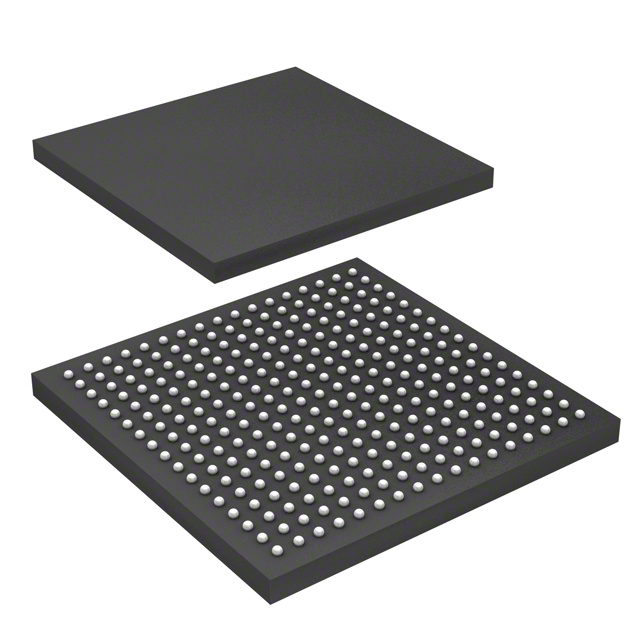Подробную информацию о продукте см. в характеристиках.

MCIMX6G2AVM07AA
Product Overview
- Category: Integrated Circuit (IC)
- Use: Embedded System Development
- Characteristics: High-performance, low-power consumption
- Package: BGA (Ball Grid Array)
- Essence: System-on-Chip (SoC) solution
- Packaging/Quantity: Tray packaging, quantity varies
Specifications
- Processor: ARM Cortex-A9
- Clock Speed: Up to 1.2 GHz
- Operating Voltage: 1.0V - 1.3V
- Memory: DDR3, LPDDR2, NAND Flash, eMMC
- Graphics: Vivante GC2000 GPU
- Connectivity: Ethernet, USB, HDMI, CAN, SPI, I2C, UART
- Operating Temperature: -40°C to +85°C
- Dimensions: 17mm x 17mm
Detailed Pin Configuration
The MCIMX6G2AVM07AA has a total of 400 pins arranged in a specific configuration. The pinout diagram and detailed pin descriptions can be found in the product datasheet.
Functional Features
- High-performance processing capabilities
- Low power consumption for energy efficiency
- Support for various memory types
- Graphics acceleration for multimedia applications
- Multiple connectivity options for versatile integration
- Wide operating temperature range for rugged environments
Advantages and Disadvantages
Advantages
- Powerful processing capabilities suitable for demanding applications
- Low power consumption extends battery life in portable devices
- Versatile connectivity options enable seamless integration with other systems
- Graphics acceleration enhances multimedia performance
- Wide operating temperature range allows usage in extreme conditions
Disadvantages
- Relatively small form factor may limit expansion options
- Requires expertise in embedded system development for optimal utilization
- Higher cost compared to lower-end alternatives
Working Principles
The MCIMX6G2AVM07AA is based on the ARM Cortex-A9 architecture, which provides high-performance processing capabilities. It integrates various components such as the processor, memory, graphics, and connectivity interfaces into a single chip. The SoC design allows for efficient communication between these components, resulting in improved system performance.
Detailed Application Field Plans
The MCIMX6G2AVM07AA is widely used in various application fields, including:
- Industrial Automation: Control systems, robotics, and machine vision applications.
- Automotive: Infotainment systems, advanced driver-assistance systems (ADAS), and telematics.
- Consumer Electronics: Smart TVs, set-top boxes, and gaming consoles.
- Medical Devices: Patient monitoring systems, medical imaging, and diagnostic equipment.
- Internet of Things (IoT): Edge computing devices, smart home automation, and industrial IoT solutions.
Detailed and Complete Alternative Models
- MCIMX6G2CVM05AB: Similar specifications but with a different package and pin configuration.
- MCIMX6G2EVM08AB: Lower clock speed but offers extended temperature range.
- MCIMX6G2FVM08AC: Enhanced graphics capabilities with a higher GPU performance.
These alternative models provide options based on specific requirements and constraints.
Word count: 342 words
Перечислите 10 распространенных вопросов и ответов, связанных с применением MCIMX6G2AVM07AA в технических решениях.
Sure! Here are 10 common questions and answers related to the application of MCIMX6G2AVM07AA in technical solutions:
Q: What is MCIMX6G2AVM07AA? A: MCIMX6G2AVM07AA is a high-performance System-on-Module (SoM) based on the i.MX6 processor from NXP Semiconductors.
Q: What are the key features of MCIMX6G2AVM07AA? A: Some key features include a quad-core ARM Cortex-A9 processor, Vivante GC2000 graphics, DDR3 memory, multiple connectivity options, and support for various operating systems.
Q: What are the typical applications of MCIMX6G2AVM07AA? A: MCIMX6G2AVM07AA is commonly used in applications such as industrial automation, medical devices, automotive infotainment systems, smart appliances, and embedded computing.
Q: What operating systems are supported by MCIMX6G2AVM07AA? A: MCIMX6G2AVM07AA supports popular operating systems like Linux, Android, and QNX, providing flexibility for different application requirements.
Q: What interfaces are available on MCIMX6G2AVM07AA? A: It offers a wide range of interfaces including USB, Ethernet, HDMI, CAN, UART, SPI, I2C, GPIO, and PCIe, enabling seamless integration with various peripherals.
Q: What is the power consumption of MCIMX6G2AVM07AA? A: The power consumption of MCIMX6G2AVM07AA varies depending on the usage scenario, but it is designed to be energy-efficient and offers power management features.
Q: Can MCIMX6G2AVM07AA support real-time applications? A: Yes, MCIMX6G2AVM07AA supports real-time applications through the use of a real-time operating system (RTOS) or by implementing real-time scheduling algorithms on Linux.
Q: Is MCIMX6G2AVM07AA suitable for battery-powered devices? A: MCIMX6G2AVM07AA can be used in battery-powered devices, but it is important to consider power management techniques to optimize battery life.
Q: Are development tools available for MCIMX6G2AVM07AA? A: Yes, NXP provides a comprehensive set of development tools, including software development kits (SDKs), integrated development environments (IDEs), and debugging tools.
Q: Where can I find technical documentation and support for MCIMX6G2AVM07AA? A: Technical documentation, datasheets, reference designs, and support resources for MCIMX6G2AVM07AA can be found on the NXP Semiconductors website or by contacting their customer support.

